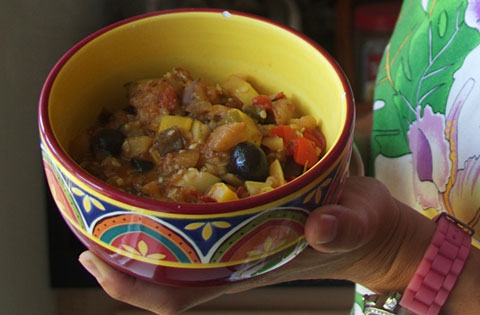
AS IT SHOULD BE Properly touillé. |
My houseguest, a sixteen-year-old French brunette, pointed at the French toast we were serving for breakfast. "What is it?" she asked.
"It's French toast!" I cried, baffled. "What — it's not French?"
"Non." She said, as confused as I was.
Well if French toast isn't French, what is? She offered to make us her favorite dinner from home: ratatouille. My first thought was that it'd be pretty good, but a little mushy. My mom used to make a vegetable stew by the same name throughout youth — along with everything else in The Moosewood Cookbook. "You don't understand," my mother recently defended her obsession with Mollie Katzen's recipes. "Before that cookbook, in the '70s it was just meat and potatoes, ketchup and mustard." After growing up on Katzen's vanguard internationally inspired vegetable dishes, I went on to become an expert in international cooking. In my professional opinion as the lead investigator at Immigrant Kitchens, I believed Katzen's ratatouille recipe, even though it delighted millions of liberated American cooks, might have missed something from the French original. And I suspected Mademoiselle Tricaud might help us find it.
I procured the ingredients she requested: garlic, zucchini, yellow summer squash, eggplant, different colored bell peppers, tomatoes, and sweet potato. "Not every one in France uses sweet potato. Just my mother," she explained. She cut up all the ingredients and cooked them in large skillet with deep sides, starting with the peppers, onions, and garlic, then adding another ingredient every five minutes or so. She served what became a red vegetable mass flecked with orange on top of fine couscous. The sweet potatoes made this ratatouille better than my mother's (nice touch Madame Tricaud!), but even Mademoiselle Tricaud was a little disappointed. It's not supposed to be mushy, she concluded. She didn't know what she did wrong.
Later, I was watching my kids swim off a public dock when I heard a French mother speaking to her children in the water. I introduced myself and explained the ratatouille situation. As it turns out, she lived just three miles from my house and offered to show me how her grandmother had taught her to make ratatouille in Provence. Provence? Really? That's the very place the dish is thought to have originated! Provencal cooks in the 1500s must have tossed together ingredients they'd worked with for thousands of years — onions, garlic, herbs, and olives — with new ingredients — tomatoes, peppers, and squashes — recently encountered in the new world, and eggplant from the Indian subcontinent.
In her Freeport kitchen, French mother Stephanie Looten-Caceres proved my theory correct! Ratatouille can be truly glorious when it's made in stages. The key is to keep the shape of each cooked ingredient intact before tossing them all together. She did this by sautéeing the peppers, eggplant, squash, and tomatoes each separately with flavorings (olive oil, herbes de Provence, garlic, onion, and black olives). Then she tossed all the cooked vegetables into a large pot where the flavors continued to meld. The result is less like a stew, as Americans have fashioned it for decades, and more a collection of chunky, cooked vegetables you spoon onto pieces of baguette, or eat with rice, couscous, or meat if you like. The name, "ratatouille," is from the French verb "touiller," which means to stir or toss — not to mush. It's delicious, healthy, and something meat eaters, vegetarians, and vegans can all enjoy together. Oh no! I've become a ratatouille evangelist just like my mother.